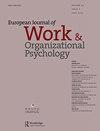The daily dynamics of basic psychological need satisfaction at work, their determinants, and their implications: An application of Dynamic Structural Equation Modeling
IF 3.4
2区 心理学
Q2 MANAGEMENT
European Journal of Work and Organizational Psychology
Pub Date : 2023-11-14
DOI:10.1080/1359432x.2023.2276534
引用次数: 0
Abstract
ABSTRACTDrawing on self-determination theory, this study focuses on the person- and occasion-specific components of the daily dynamics of employees’ global psychological need satisfaction at work. Predictors (job demands related to information and communication technologies, segmentation norms, and workload) and outcomes (perceived productivity, psychological detachment, work-family conflict, job satisfaction, and personal satisfaction) were also examined across both levels to better grasp the mechanisms underlying these short-term dynamics. A total of 129 French employees filled out questionnaire surveys at the end of each workday for five days (521 observations). Results from Dynamic Structural Equation Modeling (DSEM) showed clear associations between need satisfaction, the predictors, and the outcomes at the person-specific level. However, and although need satisfaction levels were found to fluctuate on a daily basis, they seemed immune to the effects of daily fluctuations in predictor levels, and unlikely to generate matching fluctuations in outcome levels. These results suggest strong homoeostatic processes protecting employees’ functioning against daily fluctuations, but that the accumulation of such fluctuations over the work week may jeopardize these processes.KEYWORDS: Basic psychological need satisfactionjob demandswell-beingself-determination theorydynamic structural equation modeling AcknowledgementsWe would like to thank C. Douillet, C. Delaunoy, L. Kerrouche, L. Massenet-Valac, and M. Pieltin for their invaluable help with this study’s data collection. We would also like to thank N. Stefaniak for his input during preliminary steps of data analysis.Correspondence should be addressed to Tiphaine Huyghebaert-Zouaghi; Université de Reims Champagne Ardenne; UFR Lettres et Sciences Humaines; Laboratoire Cognition, Santé, Société; 57 rue Pierre Taittinger, Reims Cedex 51 571, France. Email: tiphaine.huyghebaert@univ-reims.frDisclosure statementNo potential conflict of interest was reported by the author(s).Data availability statementData are available upon request from the authors.Supplementary materialSupplemental data for this article can be accessed online at https://doi.org/10.1080/1359432X.2023.2276534.Notes1. We hereafter use the term “global BPNS” to reflect the global experience of need satisfaction anchored in all three needs (i.e., capturing the satisfaction of all three needs in a single factor). In research anchored in basic psychological needs theory (Vansteenkiste et al., Citation2020), this terminology (i.e., global) does not reflect a trait-like level of analysis such as that proposed in Vallerand’s (Citation1997) hierarchical model of motivation.2. By lagged predictions, we mean using predictors measured at Time t to predict outcomes (e.g., BPNS) measured at Time t + 1, while controlling for the autoregressive stability of the occasion-specific outcome levels (i.e., controlling for the effects of outcome levels measured at Time t-1 on outcome levels measured at Time t).3. Preliminary analyses showed that lag 2 or 3 autoregressions or predictions did not add to the model.4. These are factor scores saved from preliminary measurement models defined using the referent indicator approach (i.e., fixing the loading and intercept of a referent indicator to respectively 1 and 0). Although this approach maximizes the similarity between the original scaling of the measure and that of the latent factors, it never perfectly replicates it. The 4 to 8 range simply reflects the fact that no participant had very low levels of BPNS and indicates that the scaling of the factor scores was slightly higher than that of the original measure (1 to 7). The 4 to 8 scale is the one relevant for interpretations.5. No evidence of a correlation was found between person-specific levels of BPNS and the random slope reflecting inter-individual differences in the size of the autoregressions (b = .016 [−.080 to .198]; β = .090).工作中基本心理需求满足的日常动态、决定因素及其含义:动态结构方程模型的应用
摘要本研究以自我决定理论为基础,探讨员工工作中整体心理需求满足的日常动态中个人和场合特定因素。预测因素(与信息和通信技术相关的工作需求、细分规范和工作量)和结果(感知生产力、心理疏离、工作-家庭冲突、工作满意度和个人满意度)也在两个层面上进行了研究,以更好地掌握这些短期动态的机制。共有129名法国员工在5天内的每个工作日结束时填写了问卷调查(521次观察)。动态结构方程模型(DSEM)的结果显示需求满意度、预测因子和个体水平的结果之间存在明显的关联。然而,尽管发现需求满意度水平每天都在波动,但它们似乎不受预测水平每天波动的影响,也不太可能在结果水平上产生相应的波动。这些结果表明,强大的同稳态过程保护员工的功能免受日常波动的影响,但这种波动在一周的工作中积累可能会危及这些过程。我们要感谢C. Douillet、C. Delaunoy、L. Kerrouche、L. Massenet-Valac和M. Pieltin在本研究数据收集方面提供的宝贵帮助。我们还要感谢N. Stefaniak在数据分析的初步步骤中提供的意见。信件应寄给Tiphaine Huyghebaert-Zouaghi;阿登香槟兰斯大学;大学文理与人文;Laboratoire Cognition, sant, society;法国兰斯Cedex 551 571, Pierre Taittinger街57号。作者未报告潜在的利益冲突。数据可用性声明数据可根据作者的要求提供。补充材料本文的补充数据可在https://doi.org/10.1080/1359432X.2023.2276534.Notes1上在线获取。此后,我们使用“全球BPNS”一词来反映以所有三种需求为基础的需求满足的全球体验(即,在单一因素中捕获所有三种需求的满足)。在以基本心理需求理论为基础的研究中(Vansteenkiste等人,Citation2020),这一术语(即,全球的)并没有反映出Vallerand (Citation1997)动机层次模型中提出的类似特质的分析水平。通过滞后预测,我们的意思是使用时间t测量的预测因子来预测时间t + 1测量的结果(例如BPNS),同时控制特定场合结果水平的自回归稳定性(即控制时间t-1测量的结果水平对时间t测量的结果水平的影响)。初步分析表明,滞后2或滞后3的自回归或预测没有加入模型。这些是使用参考指标方法(即将参考指标的载荷和截距分别固定为1和0)定义的初步测量模型中保存的因子分数。尽管这种方法最大限度地提高了测量的原始尺度与潜在因素的尺度之间的相似性,但它无法完美地复制它。4到8的范围仅仅反映了一个事实,即没有参与者的BPNS水平很低,并表明因素得分的尺度略高于原始测量(1到7)。4到8的尺度是与解释相关的。没有证据表明个体特异性BPNS水平与反映个体间自回归大小差异的随机斜率之间存在相关性(b = 0.016)。[0.80 ~ 0.198];β = 0.090)。
本文章由计算机程序翻译,如有差异,请以英文原文为准。
求助全文
约1分钟内获得全文
求助全文
来源期刊
CiteScore
8.00
自引率
2.30%
发文量
40
期刊介绍:
The mission of the European Journal of Work and Organizational Psychology is to promote and support the development of Work and Organizational Psychology by publishing high-quality scientific articles that improve our understanding of phenomena occurring in work and organizational settings. The journal publishes empirical, theoretical, methodological, and review articles that are relevant to real-world situations. The journal has a world-wide authorship, readership and editorial board. Submissions from all around the world are invited.

 求助内容:
求助内容: 应助结果提醒方式:
应助结果提醒方式:


